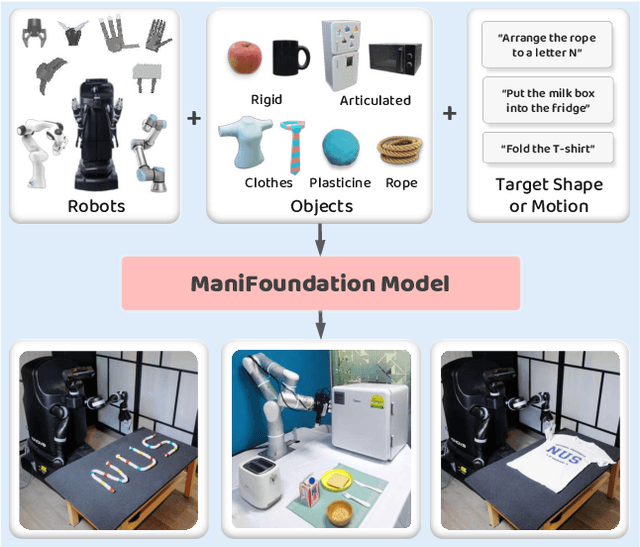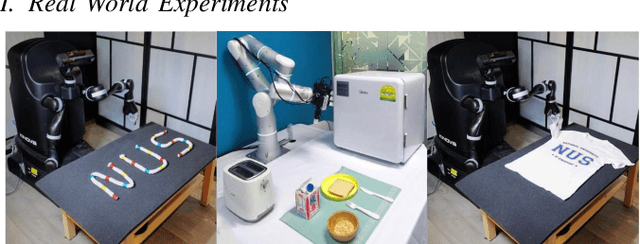Chenrui Tie
ET-SEED: Efficient Trajectory-Level SE(3) Equivariant Diffusion Policy
Nov 06, 2024Abstract:Imitation learning, e.g., diffusion policy, has been proven effective in various robotic manipulation tasks. However, extensive demonstrations are required for policy robustness and generalization. To reduce the demonstration reliance, we leverage spatial symmetry and propose ET-SEED, an efficient trajectory-level SE(3) equivariant diffusion model for generating action sequences in complex robot manipulation tasks. Further, previous equivariant diffusion models require the per-step equivariance in the Markov process, making it difficult to learn policy under such strong constraints. We theoretically extend equivariant Markov kernels and simplify the condition of equivariant diffusion process, thereby significantly improving training efficiency for trajectory-level SE(3) equivariant diffusion policy in an end-to-end manner. We evaluate ET-SEED on representative robotic manipulation tasks, involving rigid body, articulated and deformable object. Experiments demonstrate superior data efficiency and manipulation proficiency of our proposed method, as well as its ability to generalize to unseen configurations with only a few demonstrations. Website: https://et-seed.github.io/
EqvAfford: SE(3) Equivariance for Point-Level Affordance Learning
Aug 07, 2024Abstract:Humans perceive and interact with the world with the awareness of equivariance, facilitating us in manipulating different objects in diverse poses. For robotic manipulation, such equivariance also exists in many scenarios. For example, no matter what the pose of a drawer is (translation, rotation and tilt), the manipulation strategy is consistent (grasp the handle and pull in a line). While traditional models usually do not have the awareness of equivariance for robotic manipulation, which might result in more data for training and poor performance in novel object poses, we propose our EqvAfford framework, with novel designs to guarantee the equivariance in point-level affordance learning for downstream robotic manipulation, with great performance and generalization ability on representative tasks on objects in diverse poses.
ManiFoundation Model for General-Purpose Robotic Manipulation of Contact Synthesis with Arbitrary Objects and Robots
May 11, 2024



Abstract:To substantially enhance robot intelligence, there is a pressing need to develop a large model that enables general-purpose robots to proficiently undertake a broad spectrum of manipulation tasks, akin to the versatile task-planning ability exhibited by LLMs. The vast diversity in objects, robots, and manipulation tasks presents huge challenges. Our work introduces a comprehensive framework to develop a foundation model for general robotic manipulation that formalizes a manipulation task as contact synthesis. Specifically, our model takes as input object and robot manipulator point clouds, object physical attributes, target motions, and manipulation region masks. It outputs contact points on the object and associated contact forces or post-contact motions for robots to achieve the desired manipulation task. We perform extensive experiments both in the simulation and real-world settings, manipulating articulated rigid objects, rigid objects, and deformable objects that vary in dimensionality, ranging from one-dimensional objects like ropes to two-dimensional objects like cloth and extending to three-dimensional objects such as plasticine. Our model achieves average success rates of around 90\%. Supplementary materials and videos are available on our project website at https://manifoundationmodel.github.io/.
Leveraging SE(3) Equivariance for Learning 3D Geometric Shape Assembly
Sep 13, 2023



Abstract:Shape assembly aims to reassemble parts (or fragments) into a complete object, which is a common task in our daily life. Different from the semantic part assembly (e.g., assembling a chair's semantic parts like legs into a whole chair), geometric part assembly (e.g., assembling bowl fragments into a complete bowl) is an emerging task in computer vision and robotics. Instead of semantic information, this task focuses on geometric information of parts. As the both geometric and pose space of fractured parts are exceptionally large, shape pose disentanglement of part representations is beneficial to geometric shape assembly. In our paper, we propose to leverage SE(3) equivariance for such shape pose disentanglement. Moreover, while previous works in vision and robotics only consider SE(3) equivariance for the representations of single objects, we move a step forward and propose leveraging SE(3) equivariance for representations considering multi-part correlations, which further boosts the performance of the multi-part assembly. Experiments demonstrate the significance of SE(3) equivariance and our proposed method for geometric shape assembly. Project page: https://crtie.github.io/SE-3-part-assembly/
 Add to Chrome
Add to Chrome Add to Firefox
Add to Firefox Add to Edge
Add to Edge